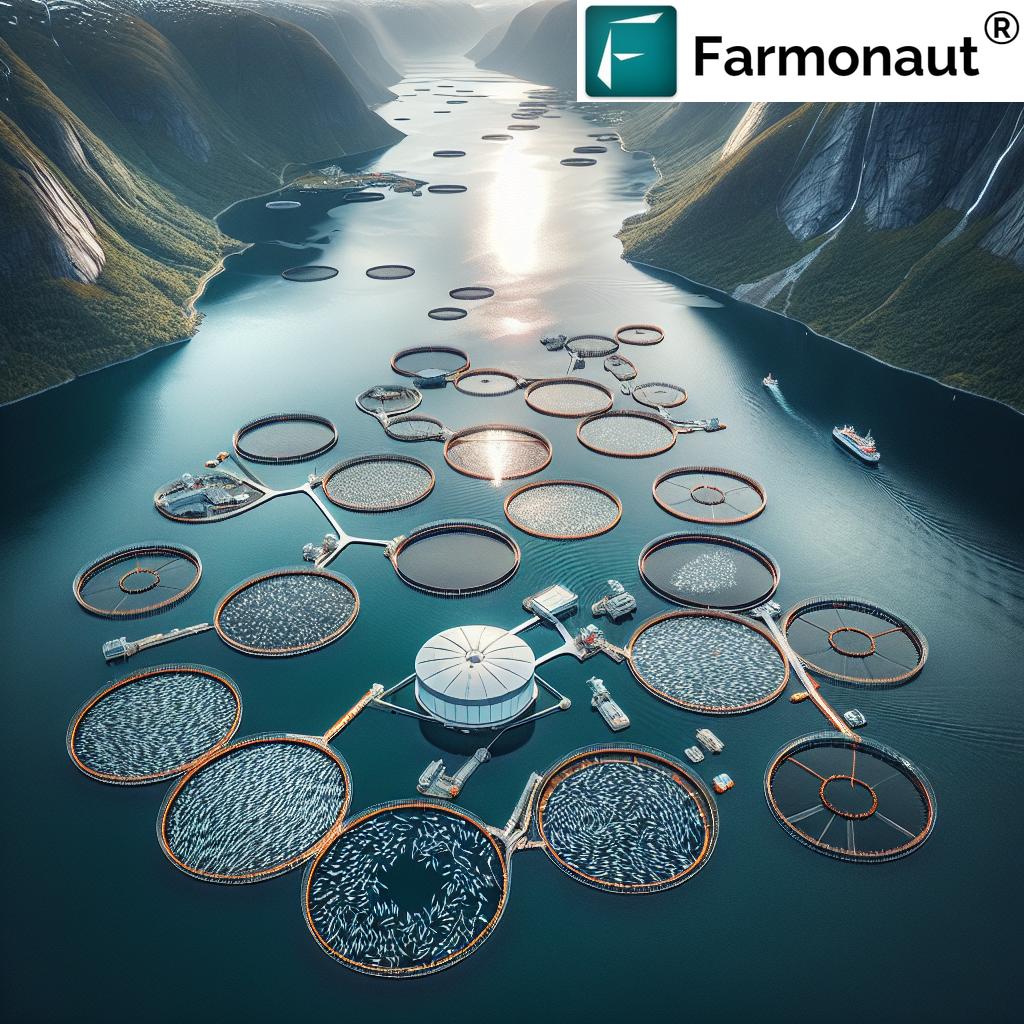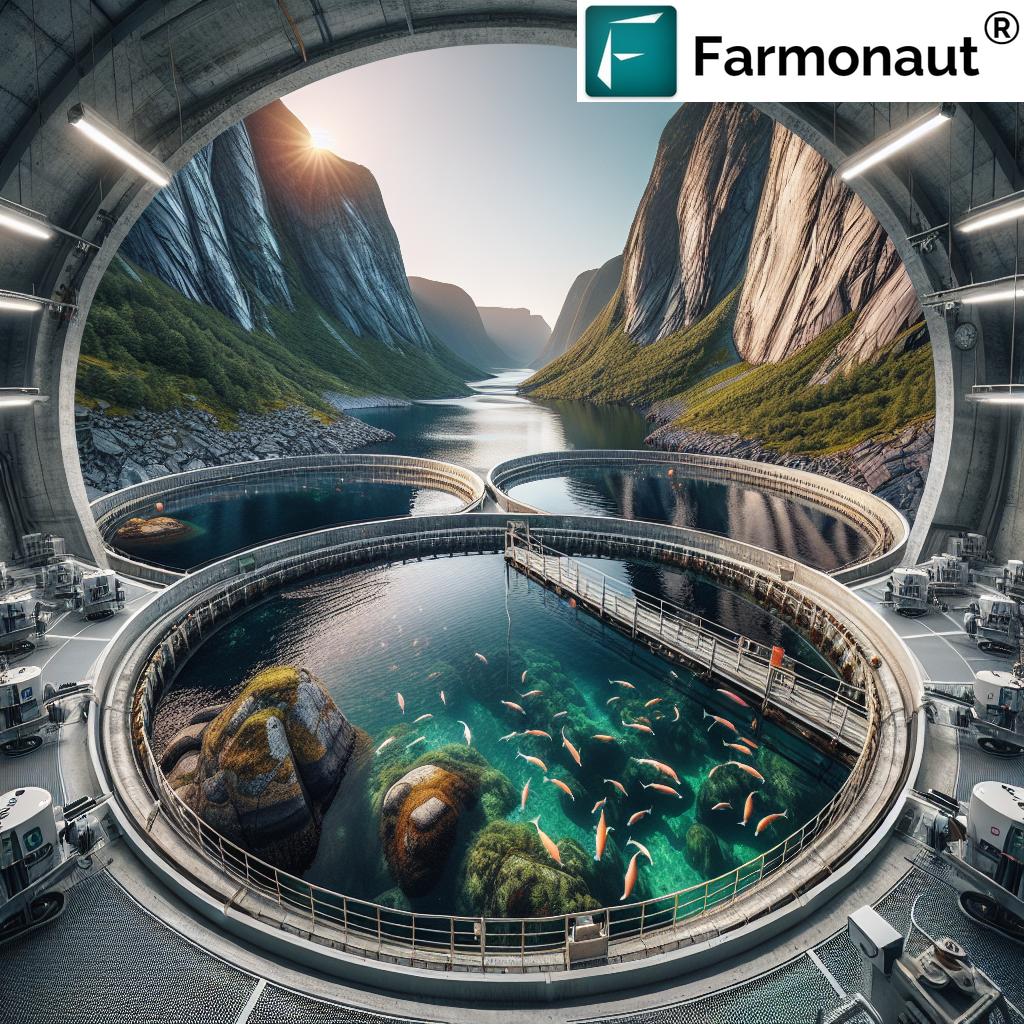Revolutionizing Salmon: Norway’s Groundbreaking Closed-Pen Aquaculture Transforms Fjords into Sustainable Fish Havens
In the heart of Norway’s stunning fjords, a quiet revolution is taking place that promises to transform the future of sustainable salmon farming. The picturesque Hardangersfjord, known for its breathtaking landscapes, is now at the forefront of aquaculture innovation, pioneering techniques that could reshape the global seafood industry. This article delves into the groundbreaking closed-pen aquaculture technology that’s turning Norwegian fjords into eco-friendly havens for Atlantic salmon, while addressing critical environmental concerns.

The Rise of Sustainable Salmon Farming in Norway
Norway has long been a global leader in salmon production, with its fjords providing ideal conditions for Atlantic salmon to thrive. The country’s dominance in salmon exports is a testament to the success of its aquaculture industry. However, this success has not come without challenges. Concerns over wild salmon conservation and the environmental impact of fish farming have pushed the industry to seek innovative solutions.
Enter the era of sustainable salmon farming Norway is pioneering. At the forefront of this movement is the Hardangersfjord salmon technology, a cutting-edge approach that’s setting new standards for Norwegian aquaculture sustainability.
Closed-Pen Aquaculture: A Game-Changer for the Industry
The heart of this revolution lies in closed-pen aquaculture innovation. Traditional open-net pens have long been criticized for their potential negative impacts on surrounding ecosystems. In contrast, closed-pen systems offer a controlled environment that addresses many of these concerns.
- Sea lice prevention: One of the most significant advantages of closed-pen systems is their ability to effectively prevent sea lice infestations, a persistent problem in salmon farming.
- Escape prevention: By creating a physical barrier between farmed and wild salmon, closed pens significantly reduce the risk of escapes, protecting wild salmon populations.
- Waste management: These systems allow for better control and treatment of waste, minimizing the environmental impact on the fjord ecosystem.
The pioneering work of entrepreneurs like Sondre Eide in Hardangersfjord is showcasing how closed-pen aquaculture innovation can revolutionize the industry. Their efforts are not just about producing salmon; they’re about creating a sustainable model for eco-friendly fish farming fjords that can be replicated worldwide.
The Salmon Eye: Educating for a Sustainable Future
In the midst of Hardangersfjord’s innovative salmon farms floats an extraordinary structure known as the Salmon Eye. This floating installation serves as both an educational center and a symbol of the industry’s commitment to sustainability. Visitors to the Salmon Eye can learn about:
- The importance of sustainable seafood practices
- The evolution of salmon farming technology
- The critical balance between aquaculture and environmental preservation
The Salmon Eye plays a crucial role in public engagement, helping to bridge the gap between consumers and producers while showcasing the advancements in Norwegian aquaculture sustainability.

Addressing Key Challenges in Salmon Farming
The closed-pen aquaculture systems in Hardangersfjord are tackling some of the most pressing issues facing the salmon farming industry:
Sea Lice Prevention
Sea lice prevention salmon strategies are at the forefront of closed-pen design. By controlling the water intake and creating a barrier between the farmed salmon and the open sea, these systems dramatically reduce the incidence of sea lice infestations. This not only improves the health and quality of farmed salmon but also protects wild salmon populations from potential infestations.
Atlantic Salmon Conservation
The closed-pen systems contribute significantly to Atlantic salmon conservation efforts. By preventing escapes and reducing the risk of disease transmission, these innovative farms help maintain the genetic integrity of wild salmon populations. This is crucial for the long-term sustainability of both farmed and wild salmon stocks.
Environmental Impact Mitigation
The environmental impact of fish farming has been a major concern for conservationists and local communities. Closed-pen systems address this by:
- Minimizing the release of waste into the surrounding waters
- Reducing the need for antibiotics and other chemicals
- Decreasing the overall ecological footprint of salmon farming operations
These advancements in Hardangersfjord salmon technology are setting new benchmarks for environmental stewardship in aquaculture.
The Global Impact of Norway’s Aquaculture Innovation
As the world grapples with the challenge of securing food supplies while preserving ocean health, Norway’s advancements in sustainable salmon farming are drawing international attention. The success of closed-pen systems in Norwegian fjords is inspiring similar initiatives around the globe, potentially transforming the aquaculture industry on a global scale.
The implications of this innovation extend beyond salmon farming. The principles and technologies developed in Hardangersfjord could be adapted for other fish species and aquaculture settings, contributing to a more sustainable and efficient global seafood industry.
The Role of Technology in Sustainable Aquaculture
The success of closed-pen aquaculture in Norway is heavily reliant on cutting-edge technology. From advanced water filtration systems to AI-powered monitoring tools, technology plays a crucial role in maintaining the health of the salmon and the surrounding ecosystem.
Farmonaut, a leader in agricultural technology, offers innovative solutions that can be applied to aquaculture. Their satellite-based monitoring systems and weather APIs provide valuable data for optimizing fish farming operations. Learn more about their services:
For easy access to Farmonaut’s cutting-edge technology:
The Future of Sustainable Salmon Farming
As Norway continues to lead the way in sustainable salmon farming, the future of the industry looks promising. The success of closed-pen systems in Hardangersfjord demonstrates that it’s possible to balance productive aquaculture with environmental conservation. Key areas of future development include:
- Further refinement of closed-pen technologies
- Integration of renewable energy sources in aquaculture operations
- Development of more sustainable fish feed options
- Expansion of the closed-pen model to other species and regions
Conclusion: A Model for Global Aquaculture
The revolutionary closed-pen aquaculture systems in Norway’s Hardangersfjord represent more than just a local success story; they offer a blueprint for sustainable fish farming worldwide. By addressing key challenges such as sea lice prevention, wild salmon conservation, and environmental impact mitigation, these innovative farms are setting new standards for the industry.
As the global demand for seafood continues to rise, the lessons learned from Norway’s fjords could play a crucial role in ensuring a sustainable future for aquaculture. The blend of cutting-edge technology, environmental stewardship, and innovative farming practices demonstrated in Hardangersfjord provides a model that could be adapted to meet the diverse challenges faced by aquaculture operations around the world.
The transformation of Norway’s fjords into sustainable fish havens is more than an environmental success—it’s a testament to human ingenuity and our capacity to evolve our food production methods in harmony with nature. As we look to the future, the innovations pioneered in Norwegian waters may well be the key to feeding a growing global population while preserving the health of our oceans for generations to come.


